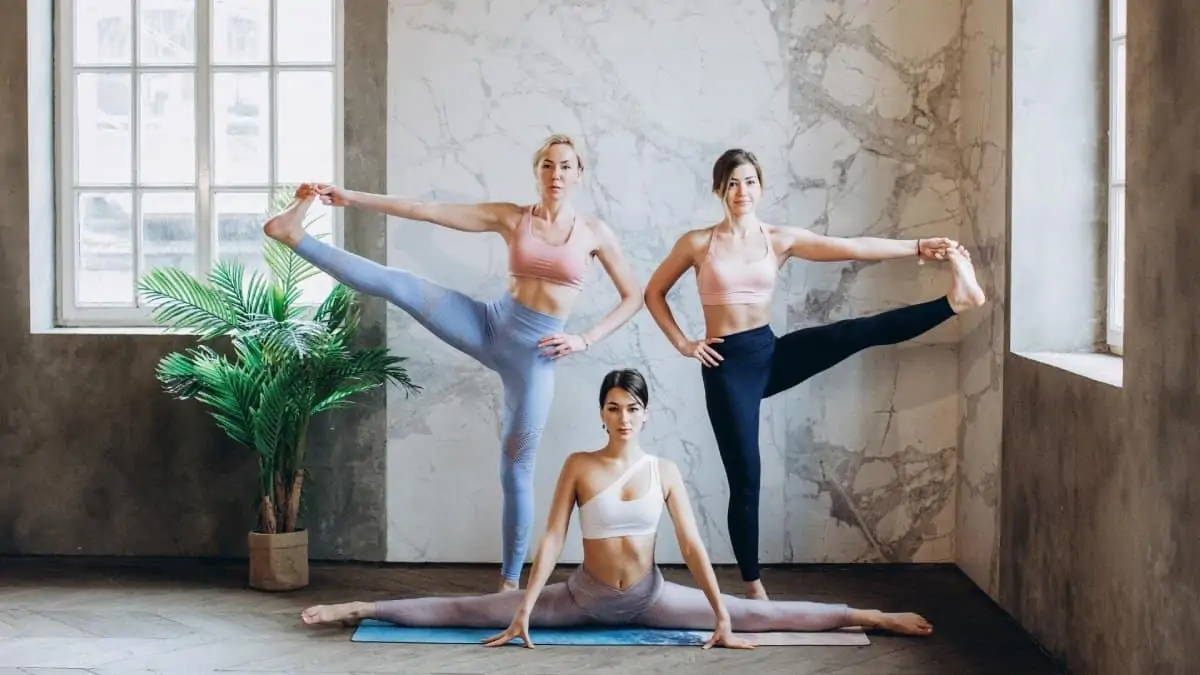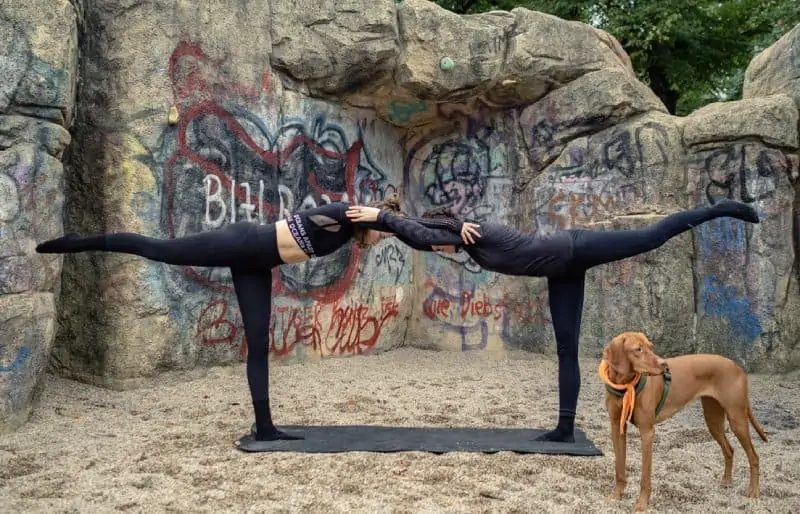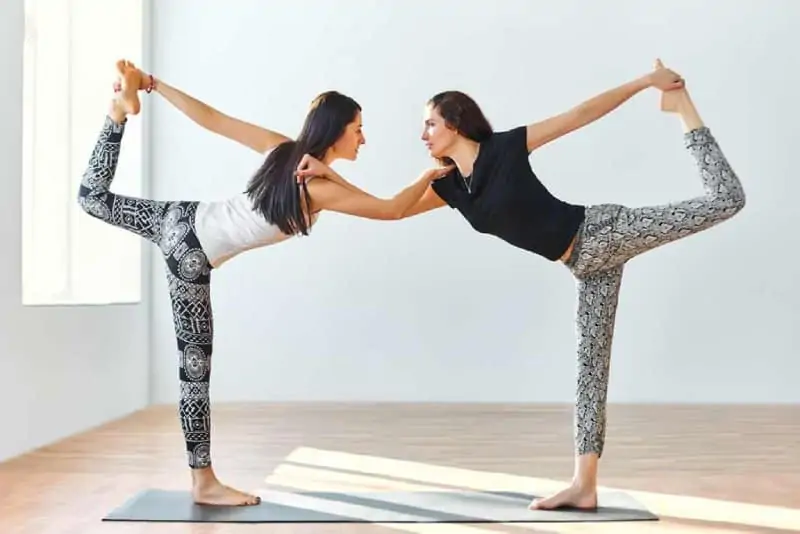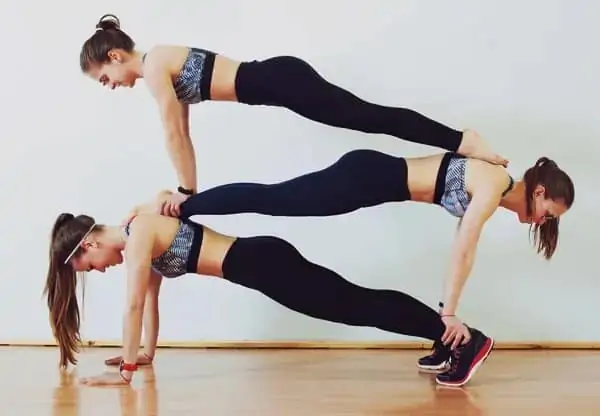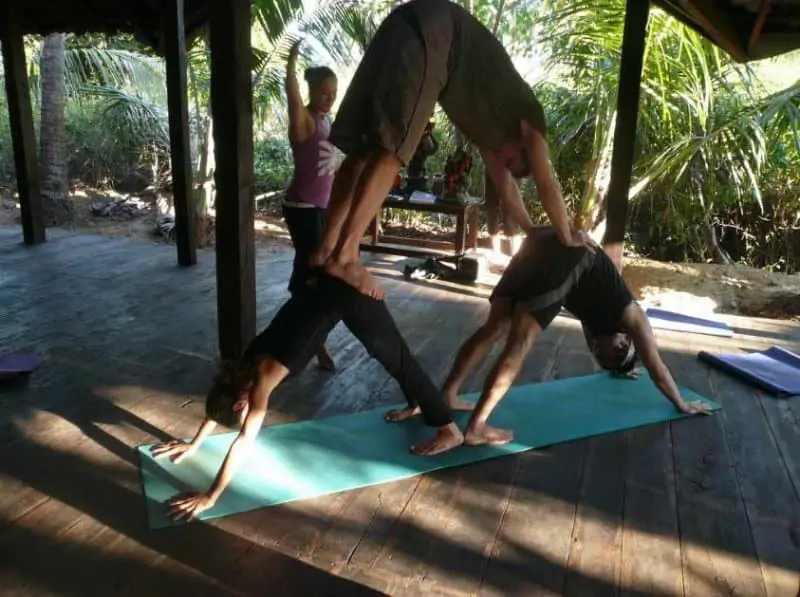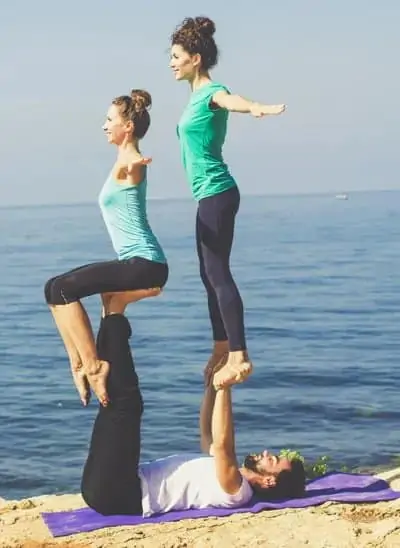Listen to this article:
Key Takeaway
Discover the joy and challenge of 3 people yoga poses, where coordination, balance, and trust are key to mastering dynamic acrobatic exercises and deepening your social connections.
Yoga has evolved beyond just you on the mat. Now you can bring in a second or even a third person to create a challenging and fun social experience of flying acrobatics, deep stretching, and creative exercise.
Trio yoga is a medley of yoga and cheerleading with a dash of zen and plenty of laughter. If you’ve been wanting to find a way to connect more with your partner, yoga friends, or even your kids, you should try out some of these incredible beginner or advanced 3 person yoga poses.
Make sure you have a spotter and a camera handy because you won’t want to miss the fun photo ops!
You can also see our best 2-person and 4-person yoga poses.
Contents
What is Acro Yoga?
If gymnastics, acrobatics, and yoga had a baby together, it would be acro yoga. This unique form of exercise and art is growing more and more popular for its many benefits and unique photo ops. One or more yogis are levitated above the ground by the base yogi’s feet or hands. Balance and communication are essential for successful acro yoga positions, but strength and flexibility help too.
While most acro yoga poses are typically for two people, we’ve tried out some super fun three-person yoga poses. Acro yoga is a true test of teamwork and trust, so be ready to engage with your fellow yogis in a way you never have before.
Key Acro Yoga Positions
The three key positions in acro yoga include:
- Base: This is the person who is usually lying flat on their back and supporting the entire pose from the bottom. The base provides all the strength and stability for the flying yogis. They are the foundation of the pose and need to be confident in their strength and abilities.
- Flyer: This is the yogi who is up in the air. Sometimes they do look like they’re flying, and other times they are simply balancing on the base’s limbs. They need to have plenty of coordination, balance, and control over their bodies to make things easier for the base. There can be one or two flyers in acro yoga poses.
- Spotter: Just like in cheerleading or weightlifting, a spotter is the “safety person” who watches everyone’s form and makes sure that nobody falls. The spotter can also be part of the pose itself. A spotter isn’t always necessary, but they are an extra peace of mind when attempting hard yoga poses with three people.
The Role of Breathwork in Acro Yoga
The significance of breathwork in trio yoga is often underestimated when exploring three-person yoga poses. Breathwork plays a role in yoga, transforming it from an activity to a moving meditation. In trio yoga, synchronizing our breath can enhance the experience, foster connections between partners, and improve the flow of our practice.
When we breathe together, our movements and intentions align harmoniously. It establishes a rhythm that guides us seamlessly from one pose to another. I’ve noticed that when my partners and I focus on our breath, we move with ease and are better equipped to support each other’s weight and maintain balance. It’s like we become one entity, flowing in sync with every breath.
By incorporating pranayama techniques like Ujjayi breath, we can further enhance our focus. Generate internal warmth, making our muscles more flexible and the practice more dynamic. It goes beyond performing poses; it’s about how shared breathwork deepens stretches while strengthening the bonds among practitioners.
Let us not forget the power of the breath as a tool. It can calm the mind, reduce stress levels, and even prevent injuries by allowing for controlled movements.
Benefits of 3 People Yoga Poses
You might be wondering, “Why should I try acro yoga with 3 people anyway?” It turns out there are a lot of mental and physical benefits to the practice.
Bonding
Whether you are practicing with a significant other, your friends, and/or a family member, trio acro yoga is a major bonding experience. I’ve even found that practicing with strangers in yoga classes results in amazing new friendships!
Trio-acro yoga is also amazing for parents to practice with a child. Regardless of their age, the support and encouragement they receive from you while attempting fun flying poses is a huge confidence boost and bonding opportunity. It’s also far easier to get kids up in the air than it is for adults.
Communication
Unlike your practice on a yoga mat, acro yoga requires talking to each other. Clear communication is of the essence when executing any 3 person yoga pose because it ensures that everyone is on the same page about where the asana is going.
It also helps you develop trust between your yoga partners. You have to be comfortable asking, “Hey, can you move your foot to the right a little bit?” or say “Keep your core tight and arms engaged” to your fellow yogis.
Strength Building
Three-person yoga, unsurprisingly, requires a lot more strength than standard yoga. You are supporting far more than your body weight, and as a result, you’re building extra muscle and balance with each practice.
Even as a flyer, you will find that you need to be more engaged and flexed than you would on your own. You will break a sweat and potentially be sore the following day! Acrobatic yoga is fun, but it’s also a major workout.
More Flexibility, Less Back Pain
You might have heard about the incredible benefits of inversions for your body. Just like in aerial yoga or poses in a yoga swing, many acro yoga poses allow you to get a far deeper stretch than you could on a yoga mat.
The spinal decompression and inversion of the body can help with back pain and simultaneously improve circulation and clarity.
Accountability and Social Connection
In general, exercising with a partner (or several) is the most motivating thing you can do. You are much more likely to get on the mat and feel motivated to move when you have friends showing up to do it with you. Scientifically, the phenomenon is called “exercise contagion.“
Acro yoga takes this contagious motivational energy to the next level because you need other people to accomplish the pose. You can connect on a new level that you probably haven’t experienced before and continue working as a team to achieve new challenges.
Three People Yoga Poses: Warm-up
Beginner yogis shouldn’t jump right into acro yoga without proper planning and practice. After all, it involves flying in the air and balancing on other people’s limbs. Acro yoga isn’t for the faint of heart and can lead to real injuries if you aren’t prepared and grounded.
It’s best to start with an easy yoga pose that gets everyone stretched out and relaxed. Ideally, there is a teacher or a member of the group leading the practice, just like you would in a normal yoga class. While standard yoga is all about connecting with your own body, acro yoga requires a conjoined effort.
Back-to-Back Lotus
Begin by sitting in a lotus pose back-to-back in a circle. Take a few breaths in unison to tune into each other’s bodies and connect with balance.
You also have to get used to being close and touching each other—not in a weird way but in a comfortable, friendly way! After all, your arms, legs, and hands will be stacked on each other and touching throughout the practice.
Triple Forward Fold
Sit in a 3-point circle with your legs extended inward and your feet touching. Take a deep inhale and fold down toward the center, interlocking your hands (or arms, depending on flexibility). Brace against each other to deepen the stretch and practice communicating about each person’s next movements.
Easy Yoga Poses for Three People
Standing poses are an excellent next step in your warm-up routine so that everyone can stretch out and hone in on their balance. You can build a solid foundation of trust before diving into more difficult poses. This warmup also allows each yogi to advance their flexibility while enjoying the balancing support of the group.
Triple Warrior III
A simple three-person take on the classic partner warrior pose, this is best done on a solid surface like wood or even grass.
- Begin in a circle with everyone facing the center
- Inhale your arms up above your head, palms facing in
- Exhale and shift your weight into the right leg
- On an inhale, hinge at the waist and let your left leg fly back behind you
- Brace all of your hands flat against each other or interlock your arms as you enter Warrior III, adjusting as needed to hold the balance
- Try to keep your body in a flat T-shaped plane with hips facing the ground
- Repeat on the other side
3-Way Lord of the Dance (Natarajasana) Pose
Lord of the Dance is a nice warm-up balancing position. Just like with two partners, you will need to experiment a bit to find the right interlocking grip.
- Start in a circle with each yogi facing the center
- Shift your weight into one leg and bend your left leg at the knee behind you
- Clasp your hand around the inside of your left ankle and slowly kick up the back glute until your foot is raised in a full ‘Lord of the Dance’ pose
- Reach your opposite arm up and forward, clasping hands with your fellow yogis in the middle of the circle
- Rely on your fellow yogis for balance and strength, breathing together
- Repeat on the other side
Box Trio
This is an easy intro to flying 3 person yoga poses. The three yogis will together make a rectangular box shape, with one partner laying flat across the top and the two other partners in an “L shape” on the ground. The chair pose is a great way to warm up and prepare for the 90° leg angle before trying out this trio pose.
- Two base people begin laying flat on their backs with their head crowns almost touching
- They both raise their legs and slightly bend their knees to allow the flyer to get into position
- The top person will adjust their shoulders onto one base’s feet and then raise their lower body onto the other
- The bases may need to slowly adjust and press their legs upward until they reach a 90° straight-legged position with feet beneath the flyer’s shoulders and toes
- The flyer remains in an active Savasana position while the bases fully support their body weight and breathe slowly
3 Person Ballet Pose
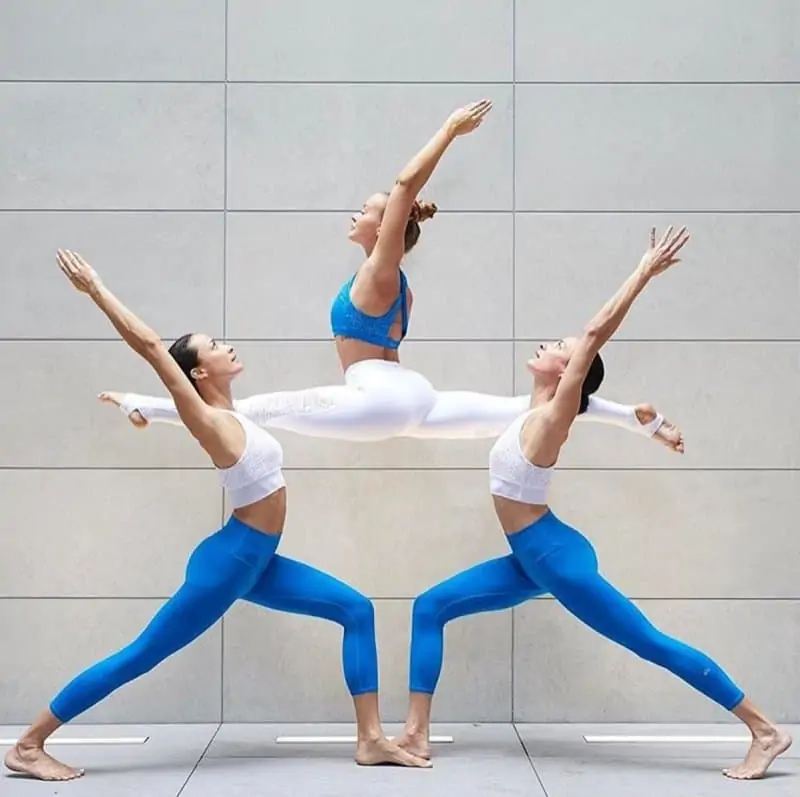
This pose requires a very flexible flyer and sturdy bases. It is a super beautiful expression that blurs the line between cheerleading, ballet, and yoga. The ballet pose also offers a deep stretch for everyone involved.
- One person can begin in a Warrior I position
- The second base should align its front toes with the other base’s heel and step backward into their Warrior I pose
- The third yogi steps onto the bases’s thighs one at a time, sort of like a cheerleading pyramid
- Then the flyer will turn to face one of the bases and lift their front leg onto one base’s shoulder, using their hands as support
- The other base can help the flyer lift their back leg into the full splits position, with each of the flyer’s shins balancing the weight evenly on the base’s shoulders
- Breathe, stay engaged, and make adjustments as needed
- Exit the same way as you entered
Challenging 3 People Yoga Poses
Trio Plank Pose
Before diving into stacked planks, everyone can practice mastering their plank pose (Phalakasana) individually. You need to be able to hold a solid plank for at least 10–15 full breaths before trying out the plank trio.
- Start with the strongest person as the base of the plank tower, holding a solid Phalakasana
- The second partner starts standing and facing the base’s feet
- To form the “middle block”, grab a firm hold on the base’s ankles and slowly place the tops of your feet onto their shoulder blades (toes pointed back), keeping the core engaged
- The top partner can then repeat the second person’s movements in the opposite direction
- Everyone should keep their necks straight and look down or slightly forward
- To release, the top flyer can slowly step off one foot at a time, and the rest can follow
Downward Dog Tower
As one of the most iconic and popular yoga poses, the downward dog position is a mild inversion with a deep hamstring and shoulder stretch. Stacking a few down-dog poses on top of each other takes things to the next level and makes for an awesome photo-op.
- One base partner begins in the classic downward dog pose
- The second base faces the first person and goes into a down dog with their hands and heads almost touching (but still a few inches apart)
- Take a deep breath and ensure that the bases are solid and their hamstrings extended as close to the ground as possible (adjust position width as needed)
- The other partner (flyer) places their hands on one base’s lower back and uses their core strength to swiftly lift their legs into a tabletop stacked on top of their partners
- The flyer then moves their feet to the shoulders of the opposite base and pushes into down dog pose to create the 3-dog pyramid
- The flyer can also lift one leg into a split dog for an extra stretch
Trio Flying Mountain and Throne Pose
This pose is a super unique yoga challenge because both flying partners are individually supporting their weight and balance without touching each other. Before attempting this yoga challenge with three people, be sure that the base has great arm strength and hamstring flexibility to hold their legs up in a 90° position.
- The base begins lying flat on its back
- The first flyer stands facing away from the base’s legs
- The base bends their legs and places their feet on the flyer’s sit bones, slowly pressing them up into a seated throne pose
- Once the first flyer is secure, the second flyer enters the foot-to-hand balance by slowly stepping onto the extended arms of the base with their full body solid and engaged
- To achieve full expression, the base should have their legs and arms fully extended with strong flexing in their muscles and laser-focus on both flyers
Ensuring Safety and Using Techniques in Trio Yoga
When it comes to trio yoga, prioritizing safety is essential. Often, in our enthusiasm to explore poses, we tend to overlook the significance of employing spotting techniques. Spotting goes beyond preventing falls; it plays a role in establishing trust and creating a safe environment for everyone involved.
To begin with, the spotter’s role is of importance. They should remain vigilant. It’s not just about catching someone if they stumble; it involves guiding the base and flyers into alignment while providing support during transitions.
Effective communication is also vital. Before attempting any pose it’s essential to discuss who will be acting as the spotter and establish signals for initiating, adjusting, or concluding the pose. This ensures that everyone is on the same page and minimizes the chances of accidents occurring.
Lastly, spotters should position themselves strategically to maximize their effectiveness. For poses where the flyer is lifted off the ground, spotters should be positioned close to quickly reach out if needed. In poses involving balances, spotters should have a view of all participants to monitor their form effectively.
Let us remember that having a spotter can make all the difference between executing a pose and risking an injury. So let us not rush into those shapes without establishing a safety net first.
Trust the Process!
Acro yoga is not easy. Getting into 3 person yoga poses can be frustrating and confusing, so be sure to practice patience and laugh off the mistakes. Each position takes its process of perfecting and practicing over time.
Have you tried any of these acro positions before?
Namaste!
Pop quiz! 🧘🤔
In acro yoga, the base is the person who is usually flying in the air.
Communication is not important in 3 people yoga poses since the poses are mostly about physical strength.
Acro yoga can be a bonding experience and is suitable for practicing with friends, partners, or even kids.


